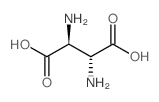meso-2 3-diaminosuccinic acid

meso-2 3-diaminosuccinic acid structure
|
Common Name | meso-2 3-diaminosuccinic acid | ||
|---|---|---|---|---|
| CAS Number | 23220-52-2 | Molecular Weight | 148.11700 | |
| Density | 1.611g/cm3 | Boiling Point | 304.7ºC at 760mmHg | |
| Molecular Formula | C4H8N2O4 | Melting Point | N/A | |
| MSDS | Chinese USA | Flash Point | 138.1ºC | |
| Symbol |

GHS07 |
Signal Word | Warning | |
|
Elution behavior of diaminopimelic acid and related diamino acids using the advanced Marfey's method.
J. Chromatogr. A. 1160(1-2) , 246-53, (2007) The advanced Marfey's method consists of a chromatography technique for the separation of amino acids into each enantiomer by derivatization with 1-fluoro-2,4-dinitrophenyl-5-L-leucinamide (L-FDLA), and a detection method using liquid chromatography/mass spec... |
|
|
Oxidation of meso-diaminosuccinic acid, a possible natural substrate for D-aspartate oxidase.
Eur. J. Biochem. 117(3) , 635-8, (1981) meso-Diaminosuccinic acid, a natural antagonist of aspartic acid, is a good substrate for beef kidney D-aspartate oxidase. The oxygen consumption and the ammonia production are in good agreement with the stoichiometry of a typical oxidative deamination. The d... |
|
|
3-Azido-aspartic acid derivatives - orthogonally protected precursors for the stereoselective incorporation of 2,3-diaminosuccinic acid into peptide structures.
J. Pept. Res. 63(3) , 196-9, (2004) The stereoselective synthesis of orthogonally protected 3-azido aspartic acid derivatives is described. The convenience of their application as 2,3-diaminosuccinic acid in peptide chemistry was demonstrated by the incorporation of the nonproteinogenic diamino... |
|
|
A short diastereoselective synthesis of orthogonally protected diaminosuccinic acid derivatives.
J. Org. Chem. 69(18) , 6134-6, (2004) Homogeneous, Rh-catalyzed hydrogenation of heteromeric olefinic glycine dimers presents an efficient route to diastereomerically pure, orthogonally protected diaminosuccinic acid derivatives depending on the double bond geometry of the starting material. The ... |
|
|
Monte Carlo track-structure calculations for aqueous solutions containing biomolecules.
Basic Life Sci. 63 , 155-66, (1994) Detailed Monte Carlo calculations provide a powerful tool for understanding mechanisms of radiation damage to biological molecules irradiated in aqueous solution. This paper describes the computer codes, OREC and RADLYS, which have been developed for this pur... |